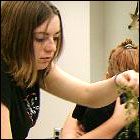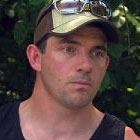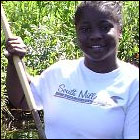Whitney Hollowell - ECSU
 Before coming into the Watershed Watch Program, I really did not know what a watershed was or how it affected the environment. Throughout the Watershed Program, I have become very interested in how trees and other plants are affected by their environment. While in the Great Dismal Swamp, I was fascinated by how certain trees appeared healthier in some areas compared to other areas. This interest in healthier trees sparked an idea for my research project. Before coming into the Watershed Watch Program, I really did not know what a watershed was or how it affected the environment. Throughout the Watershed Program, I have become very interested in how trees and other plants are affected by their environment. While in the Great Dismal Swamp, I was fascinated by how certain trees appeared healthier in some areas compared to other areas. This interest in healthier trees sparked an idea for my research project.
The research topic that my group chose was to examine a Bald Cypress tree that has lived in the Great Dismal Swamp’s Washington Ditch and compare it to another Bald Cypress on dry land. The group and I used the Visible Infra-Red Intelligent Spectrometer (VIRIS) to estimate the amount of chlorophyll in the tree’s foliage. Also, we made thin-sections of the cypress needles and examined wood increment cores under the microscope. |
|
Allie Collopy - UNH
 My research focus was the effect of urbanization on water quality within the Pasquotank watershed. Impervious surfaces and other signs of urban development all have an enormous effect on aquatic systems, and I studied these impacts by examining 16 samples from within the watershed. In order to test for water quality, I looked specifically at pH levels, dissolved oxygen levels, turbidity, conductivity, salinity and water temperatures, and constrasted these numbers to the standards the North Carolina Division of Water Quality uses to determine what water is of good quality, and what water is poor. I hypothesize that as urbanization increases, water quality within the Pasquotank will decrease. My research focus was the effect of urbanization on water quality within the Pasquotank watershed. Impervious surfaces and other signs of urban development all have an enormous effect on aquatic systems, and I studied these impacts by examining 16 samples from within the watershed. In order to test for water quality, I looked specifically at pH levels, dissolved oxygen levels, turbidity, conductivity, salinity and water temperatures, and constrasted these numbers to the standards the North Carolina Division of Water Quality uses to determine what water is of good quality, and what water is poor. I hypothesize that as urbanization increases, water quality within the Pasquotank will decrease.
|
|
Robert Haile - NHCTC
 The purpose of my project is to research what effects the predicted rise in sea level could possibly have on coastal regions of North Carolina. With the predicted rise in sea level it will be important to be able to create models that could predict coastal areas that would be affected. The Intergovernmental Panel on Climate Change (IPCC) predicts that the global sea level will rise by an estimated 4 feet by the year 2100. This estimate does not take into consideration the possible collapse of either the West Antarctica Ice Sheet or the Greenland Ice Sheet; both scenarios have the potential to create a rise in sea level of up to 20 feet. This would completely alter the coastal landscape of North Carolina. The goal of my research is to be able to create two models that will illustrate the effects that two varying scenarios will have. The first model showing the effects of the estimated 4 foot rise in sea level, the second illustration the effects of the worst case scenario of an estimated 20 foot rise in sea level. The purpose of my project is to research what effects the predicted rise in sea level could possibly have on coastal regions of North Carolina. With the predicted rise in sea level it will be important to be able to create models that could predict coastal areas that would be affected. The Intergovernmental Panel on Climate Change (IPCC) predicts that the global sea level will rise by an estimated 4 feet by the year 2100. This estimate does not take into consideration the possible collapse of either the West Antarctica Ice Sheet or the Greenland Ice Sheet; both scenarios have the potential to create a rise in sea level of up to 20 feet. This would completely alter the coastal landscape of North Carolina. The goal of my research is to be able to create two models that will illustrate the effects that two varying scenarios will have. The first model showing the effects of the estimated 4 foot rise in sea level, the second illustration the effects of the worst case scenario of an estimated 20 foot rise in sea level. |
|
Travis Toomire - NHCTC
 I would like to know if a Bald Cypress tree living on land would be healthier than or not as healthy as a Bald Cypress tree living in the water. The study location is the Washington Ditch area of The Great Dismal Swamp National Wildlife Refuge. To do this we are going to core
Bald Cypress trees from the Great Dismal Swamp. We will be looking at comparisons through a microscope to see if there is any difference between the two subjects. Our hypothesis is that the one on land will be a bit healthier than the one growing in the water, because it gets m direct sunlight and more rain water, as opposed to the tree that is continually being given nutrients, which may prove to be more nutrients than it really needs. I would like to know if a Bald Cypress tree living on land would be healthier than or not as healthy as a Bald Cypress tree living in the water. The study location is the Washington Ditch area of The Great Dismal Swamp National Wildlife Refuge. To do this we are going to core
Bald Cypress trees from the Great Dismal Swamp. We will be looking at comparisons through a microscope to see if there is any difference between the two subjects. Our hypothesis is that the one on land will be a bit healthier than the one growing in the water, because it gets m direct sunlight and more rain water, as opposed to the tree that is continually being given nutrients, which may prove to be more nutrients than it really needs. |
|
Krystal de Leon - COA
 I am interested in researching the Bald Cypress tree also known as The Big Tree in the Great Dismal Swamp. I am studying the age of the tree by coring it with an increment coring instrument and counting the rings that are on the core and multiplying it due to rottenness. I will also estimate the height before it broke apart and measure the effects in the trees height it had later on. I am interested in researching the Bald Cypress tree also known as The Big Tree in the Great Dismal Swamp. I am studying the age of the tree by coring it with an increment coring instrument and counting the rings that are on the core and multiplying it due to rottenness. I will also estimate the height before it broke apart and measure the effects in the trees height it had later on. |
|
Erin Callum - COA
 Watersheds are important parts of any and every region on earth. It is important to preserve them. I am interested in finding out the correlation between water quality and diversity of Marco invertebrates. I am exploring the properties of different parts of the Pasquotank watershed that have the most affect on the diversity of Macro invertebrates. I have taken samples from many different parts of the vast Pasquotank Watershed, starting with the head waters of Lake Drummond and finishing with the Currituck Sound. Water properties as well as macro invertebrates have been identified from each sample. It has been a fascinating journey that I am eager to compile and analyze the date. It has been a very rewarding experience that I will never forget! Watersheds are important parts of any and every region on earth. It is important to preserve them. I am interested in finding out the correlation between water quality and diversity of Marco invertebrates. I am exploring the properties of different parts of the Pasquotank watershed that have the most affect on the diversity of Macro invertebrates. I have taken samples from many different parts of the vast Pasquotank Watershed, starting with the head waters of Lake Drummond and finishing with the Currituck Sound. Water properties as well as macro invertebrates have been identified from each sample. It has been a fascinating journey that I am eager to compile and analyze the date. It has been a very rewarding experience that I will never forget! |
|
Taneisha Kee - ECSU
 My research focus is the study of aquatic toxicology. My goal is to determine the quality of water in the Great Dismal Swamp and Currituck Sound. To begin my research project, I posed the question what is Aquatic Toxicology? Aquatic Toxicology is the study of the effects of chemicals, and other natural materials (caused or produced by humans), on organisms in the aquatic area. My objective is to test water samples from The Great Dismal Swamp, Pasquotank River, Elizabeth City State University and Currituck Sound collecting the pH, salinity, turbidity and the diversity around that particular area. To help determine the diversity, I will observe the animals and types of trees in the area. By doing this at every site, I will be able to collect organisms such as micro invertebrates and group them by ecosystems. My research focus is the study of aquatic toxicology. My goal is to determine the quality of water in the Great Dismal Swamp and Currituck Sound. To begin my research project, I posed the question what is Aquatic Toxicology? Aquatic Toxicology is the study of the effects of chemicals, and other natural materials (caused or produced by humans), on organisms in the aquatic area. My objective is to test water samples from The Great Dismal Swamp, Pasquotank River, Elizabeth City State University and Currituck Sound collecting the pH, salinity, turbidity and the diversity around that particular area. To help determine the diversity, I will observe the animals and types of trees in the area. By doing this at every site, I will be able to collect organisms such as micro invertebrates and group them by ecosystems. |
|
Michelle Jennings - COA
 My research is focused on studying viability of zooplankton populations under drastic pH and salinity conditions. The reason why I am focusing on this issue is because it is a part of the food chain, and if something drastic changed in the zooplanktons environment to where they all collapsed then the food chain would be broken and the animals would deplete as well. I hope to prove that drastic changes in the environments in which these zooplankton live, will result in zooplankton population crashes. I think information from my research can help save the food chain if something were to happen. My research is focused on studying viability of zooplankton populations under drastic pH and salinity conditions. The reason why I am focusing on this issue is because it is a part of the food chain, and if something drastic changed in the zooplanktons environment to where they all collapsed then the food chain would be broken and the animals would deplete as well. I hope to prove that drastic changes in the environments in which these zooplankton live, will result in zooplankton population crashes. I think information from my research can help save the food chain if something were to happen. |
|
Morgan Bednarek - COA
 The purpose of my research project is to study aquatic toxicology in coastal North The purpose of my research project is to study aquatic toxicology in coastal North
Carolina. By comparing water samples from Lake Drummond, Currituck Sound, and an agricultural pond, I hope to be able to compare and contrast the differences in organism diversity and water purity. The main hypothesis is to see if there is a difference between an agricultural site and a more natural lake. If there are differences, what are they and what makes them different. By the end of this project
I hope to be able to explain the differences and make decisions about how to protect our environment. |
|
Tristen Kent - COA
 The purpose of my project is to see if agriculture affects the water quality which ultimately affects the animals that live there. I will be testing this by comparing three locations; Lake Drummond, an agricultural pond, and Currituck Sound. The sound is going to be undisturbed, Lake Drummond is going to be minorly disturbed, and our agricultural pond location will have plenty of run-off from farm land. In comparing each location we will be looking at water quality (pH, turbidity, conductivity, salinity, and macroinvertebrates). Then I'll be comparing the different macroinvertebrates that were counted in each sample location. By comparing the macroinvertebrates and water quality, I will test my hypothesis that the agricultural pond will have the least amount of macroinvertebrates due to decreased water quality from pesticides. The purpose of my project is to see if agriculture affects the water quality which ultimately affects the animals that live there. I will be testing this by comparing three locations; Lake Drummond, an agricultural pond, and Currituck Sound. The sound is going to be undisturbed, Lake Drummond is going to be minorly disturbed, and our agricultural pond location will have plenty of run-off from farm land. In comparing each location we will be looking at water quality (pH, turbidity, conductivity, salinity, and macroinvertebrates). Then I'll be comparing the different macroinvertebrates that were counted in each sample location. By comparing the macroinvertebrates and water quality, I will test my hypothesis that the agricultural pond will have the least amount of macroinvertebrates due to decreased water quality from pesticides. |
|
Katrina Clement - ECSU
 While in the Watershed program I became very interested in trees and various types of Submerged Aquatic Vegetation (SAV). I decided to attempt to explain how humans affect the environment and impact trees and SAV. Also, I am interested in how some tree species, like Bald Cypress, can live in water and on dry land. In order to solve this riddle I have to learned how to core trees to estimate their age and growth rates, estimate the height of the tree, and report all my data. While in the Watershed program I became very interested in trees and various types of Submerged Aquatic Vegetation (SAV). I decided to attempt to explain how humans affect the environment and impact trees and SAV. Also, I am interested in how some tree species, like Bald Cypress, can live in water and on dry land. In order to solve this riddle I have to learned how to core trees to estimate their age and growth rates, estimate the height of the tree, and report all my data. |
|
Christopher Ewers - ECSU
 My research focus deals with the diversity of microinvertebrates in different locations throughout the Pasquotank River Watershed and Currituck Sound. I focus on classifying different species of microinvertebrates, including copepods, Bosmina, nauplii, ostracods, and Holopedium. My research focus deals with the diversity of microinvertebrates in different locations throughout the Pasquotank River Watershed and Currituck Sound. I focus on classifying different species of microinvertebrates, including copepods, Bosmina, nauplii, ostracods, and Holopedium. |
|
Monique Harris - ECSU
 I am interested in studying knees of Bald Cypress trees. My research will consist of me cutting knees from the campus of Elizabeth City State University. I will examine the knees to determine if the older knees function as air conducting tissues after they reach a certain age, or if the smaller (and presumably younger) knees are providing oxygen to the rates. The results from my research suggest that both the old and young cypress knees are capable of transporting air to the tree. I am interested in studying knees of Bald Cypress trees. My research will consist of me cutting knees from the campus of Elizabeth City State University. I will examine the knees to determine if the older knees function as air conducting tissues after they reach a certain age, or if the smaller (and presumably younger) knees are providing oxygen to the rates. The results from my research suggest that both the old and young cypress knees are capable of transporting air to the tree. |
|
Tryselia Adler - UNH
 My research focused on the chemical and physical composition of the Pasquotank River Watershed, and how it affects the diversity of micro- and macroinvertebrates. My research conducted at Elizabeth City State University only fulfilled a fraction of my interest. As part of a research team, which included Erin Callum and Chris Ewers, we gathered information from fourteen sites along the watershed. Three sites were from the Great Dismal Swamp, nine sites were from the Pasquotank River, and two sites were from Currituck Sound. At each site the chemical properties of the water we tested to determine the levels dissolved oxygen, turbidity, salinity, and conductivity. In the lab, the water was tested using a spectrophotometer to determine the absorbance levels of different particles. While I focused on determining the overall quality of water for each site, my partners were determining the diversity of the micro- and macroinvertebrates. When our data is pulled together we will look at sites of low micro and macroinvertebrate diversity and compare it to the water quality of the site. If there is a trend of low diversity and poor water quality (high turbidity, low pH and dissolved oxygen levels) or a presence of high diversity and healthy water (high dissolved oxygen levels, neutral pH, low turbidity) our results are in agreement with our hypothesis. My research focused on the chemical and physical composition of the Pasquotank River Watershed, and how it affects the diversity of micro- and macroinvertebrates. My research conducted at Elizabeth City State University only fulfilled a fraction of my interest. As part of a research team, which included Erin Callum and Chris Ewers, we gathered information from fourteen sites along the watershed. Three sites were from the Great Dismal Swamp, nine sites were from the Pasquotank River, and two sites were from Currituck Sound. At each site the chemical properties of the water we tested to determine the levels dissolved oxygen, turbidity, salinity, and conductivity. In the lab, the water was tested using a spectrophotometer to determine the absorbance levels of different particles. While I focused on determining the overall quality of water for each site, my partners were determining the diversity of the micro- and macroinvertebrates. When our data is pulled together we will look at sites of low micro and macroinvertebrate diversity and compare it to the water quality of the site. If there is a trend of low diversity and poor water quality (high turbidity, low pH and dissolved oxygen levels) or a presence of high diversity and healthy water (high dissolved oxygen levels, neutral pH, low turbidity) our results are in agreement with our hypothesis. |
|
C. Richard Harris - NHCTC
 I am interested studying the landscape and shrubbery of the Great Dismal Swamp in attempt to verify the Indian legend of the mystical Healing Pond, which healed the animals of the swamp that were wounded by hunters. Also, I am interested in using satellite remote sensing to find potential sites where the Indians from the Powhatan Federation would have lived in the Great Dismal Swamp, by comparing the vegetation mentioned in the written accounts of the Indian legends to both Landsat imagery and a topographical maps. Trees and shrubs that were very beneficial to the Indians’ survival were Common Elderberry, American Hazelnut, Swamp Chestnut Oak, and Common Winterberry. I am interested studying the landscape and shrubbery of the Great Dismal Swamp in attempt to verify the Indian legend of the mystical Healing Pond, which healed the animals of the swamp that were wounded by hunters. Also, I am interested in using satellite remote sensing to find potential sites where the Indians from the Powhatan Federation would have lived in the Great Dismal Swamp, by comparing the vegetation mentioned in the written accounts of the Indian legends to both Landsat imagery and a topographical maps. Trees and shrubs that were very beneficial to the Indians’ survival were Common Elderberry, American Hazelnut, Swamp Chestnut Oak, and Common Winterberry. |
|
Lachrishon Reed - ECSU
 My research focus is on examining zooplankton from the Currituck Sound. I place them into different environments to see what chemical conditions these particular microinverterbrates can withstand before they die. Obtaining plankton samples from the Currituck Sound and placing them in different varying pH and salinity solutions of water will determine the plankton’s limits of survival. I am getting the measurements of pH and the salinity. From my observations it seems the plankton are dying off rapidly when put into high pH environments. Through my experiment I want to show that the zooplankton are less likely to survive in higher pH environments. My research focus is on examining zooplankton from the Currituck Sound. I place them into different environments to see what chemical conditions these particular microinverterbrates can withstand before they die. Obtaining plankton samples from the Currituck Sound and placing them in different varying pH and salinity solutions of water will determine the plankton’s limits of survival. I am getting the measurements of pH and the salinity. From my observations it seems the plankton are dying off rapidly when put into high pH environments. Through my experiment I want to show that the zooplankton are less likely to survive in higher pH environments. |
|
| |
|